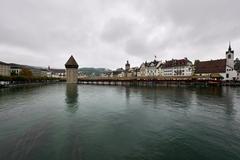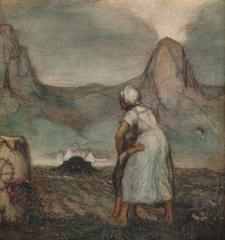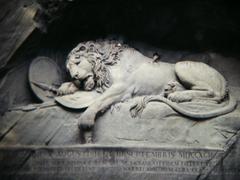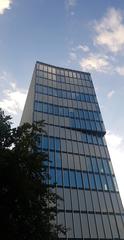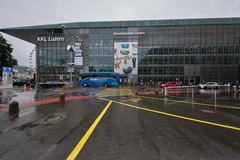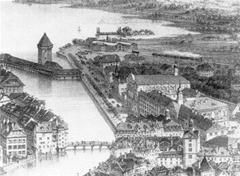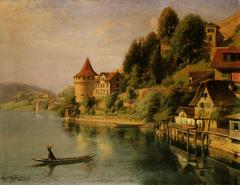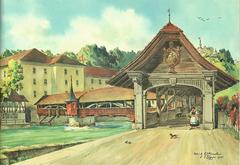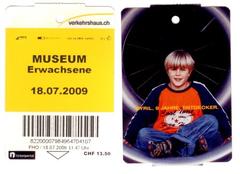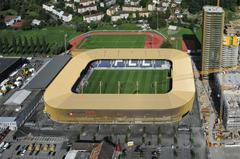
Chapel Bridge Lucerne: Visiting Hours, Tickets, and Historical Sites Guide
Date: 14/06/2025
Introduction
The Chapel Bridge (Kapellbrücke) in Lucerne, Switzerland, stands as one of Europe’s most iconic and historically significant landmarks. Constructed in the 14th century, this covered wooden bridge is not only a marvel of medieval engineering but also a vibrant symbol of Lucerne’s rich heritage. Its unique diagonal span across the Reuss River historically linked the Old Town to the New Town, playing a crucial role in the city’s defense and commerce. Adorned with a series of 17th-century triangular paintings that narrate Lucerne’s and Switzerland’s past, the Chapel Bridge invites visitors to immerse themselves in centuries of culture, art, and history.
Open 24 hours a day with free admission, the Chapel Bridge is accessible to all, making it an essential destination for travelers, history enthusiasts, and art lovers. Its central location places it within walking distance of other key attractions, such as the Water Tower, Spreuer Bridge, and the Old Town, further enriching the visitor experience. This comprehensive guide details the bridge’s origins, architectural features, artwork, visitor information, travel tips, and nearby attractions, ensuring an enriching visit.
For authoritative resources, consult Kapellbrücke.com, Lucerne.com, and Switzerlandical.com.
Table of Contents
- Introduction
- Origins and Medieval Construction
- Architectural Evolution
- Artistic Heritage: The Triangular Paintings
- The Bridge in Lucerne’s Fortifications
- The 1993 Fire and Restoration
- Visiting Hours and Tickets
- Accessibility and Travel Tips
- Nearby Attractions
- Visual Experience and Photography
- Guided Tours and Special Events
- Frequently Asked Questions (FAQ)
- Conclusion
- References
Origins and Medieval Construction
The Chapel Bridge (Kapellbrücke) was constructed between 1333 and 1360 as part of Lucerne’s medieval fortifications (e-a-a.com; kapellbruecke.com). Strategically built to span the Reuss River diagonally, it connected the Old Town (Altstadt) and New Town (Neustadt), facilitating the movement of people and goods and serving as a defensive barrier against invaders.
Adjacent to the bridge stands the octagonal Water Tower (Wasserturm), built around 1290–1300, which predates the bridge itself. The Water Tower served diverse purposes over the centuries—including as a watchtower, prison, treasury, and archive (luzern.com).
At its original length of 279 meters, the Chapel Bridge was the longest covered wooden bridge in Europe. Today, after 19th-century modifications, it measures 205 meters and remains the second-longest covered wooden bridge on the continent (kapellbruecke.com).
Architectural Evolution
The bridge’s construction showcases a medieval timber truss design with a pitched roof, protecting both the structure and its users from the elements (e-a-a.com). Built from sturdy local wood, the bridge’s diagonal crossing was a tactical response to the city’s topography and defensive needs.
Urban development in the 19th century necessitated shortening the bridge by 74 meters to its present length (kapellbruecke.com). Despite these changes, the Chapel Bridge continues to serve as a vital pedestrian link and historic landmark.
The Water Tower, with a height of 34.5 meters and a circumference of 39 meters, further exemplifies Lucerne’s multifaceted medieval fortifications (luzern.com).
Artistic Heritage: The Triangular Paintings
A defining feature of the Chapel Bridge is the series of 17th-century triangular paintings created between 1614 and 1624 by Hans Heinrich Wägmann and his workshop (switzerlandical.com). Originally numbering 158, these tempera-on-wood panels depict episodes from Lucerne’s history, the Swiss Confederation’s founding, and the lives of patron saints St. Leodegar and St. Maurice.
The paintings, often sponsored by local guilds and citizens, reflect Lucerne’s civic pride and deep Catholic heritage during the Counter-Reformation (e-a-a.com). Each panel is accompanied by brief German inscriptions, inviting visitors to engage with the city’s past in a uniquely visual way.
Today, about 30 original paintings remain after the devastating 1993 fire, with restored or replica panels filling some gaps (kapellbruecke.com). Contemporary artworks temporarily replace some paintings during Carnival celebrations, preserving the originals (switzerlandical.com).
The Bridge in Lucerne’s Fortifications
The Chapel Bridge was one of three main covered bridges forming Lucerne’s medieval defenses, alongside the Spreuer Bridge (built in 1408) and the now-lost Court Bridge (circa 1265) (kapellbruecke.com). Each bridge featured its own cycle of paintings and controlled crucial access points to the city, creating a formidable barrier and supporting troop and supply movements.
The 1993 Fire and Restoration
On August 18, 1993, a catastrophic fire ravaged the Chapel Bridge, destroying two-thirds of the structure and over half of its paintings (luzern.com). Only the two bridgeheads and Water Tower survived. The fire’s aftermath was a national tragedy, but restoration began immediately, using traditional materials and techniques to preserve the bridge’s historic character. The bridge reopened on April 14, 1994, and today, blackened panels serve as a poignant reminder of its resilience (kapellbruecke.com).
Visiting Hours and Tickets
The Chapel Bridge is open to the public 24 hours a day, seven days a week.
Admission is free, and no tickets are required to walk across the bridge or view its paintings (explorial.com).
The Water Tower is generally closed to visitors, but may open for special events or guided tours, which could require tickets (explorial.com).
Accessibility and Travel Tips
- Wheelchair Access: The bridge has a flat, wide pathway, making it accessible for wheelchairs and strollers, though some wooden planks may be uneven.
- Best Times to Visit: Early mornings, late afternoons, or at night are best to avoid crowds and to enjoy atmospheric lighting for photography (WanderInEurope).
- Transportation: Chapel Bridge is a short walk from Lucerne’s main train station and is easily reachable by bus or tram (Tripoto).
- Etiquette: Bicycles and scooters are not allowed on the bridge. Please respect signage and avoid touching the paintings.
- Facilities: Public restrooms are available nearby in the Old Town. The bridge is covered, providing shelter from rain and sun, but wooden surfaces may be slippery when wet.
Nearby Attractions
Chapel Bridge is perfectly positioned for exploring Lucerne’s other highlights:
- Spreuer Bridge: Another covered bridge with its own cycle of paintings.
- Water Tower: Iconic symbol of Lucerne, adjacent to Chapel Bridge.
- Old Town (Altstadt): Medieval streets with frescoed buildings, shops, and cafés.
- Lion Monument: Rock relief commemorating Swiss Guards.
- Musegg Wall: Preserved medieval city fortification with towers.
- Jesuit Church: Renowned for its baroque architecture.
- Lakeside promenades: Scenic walks along Lake Lucerne.
- Swiss Museum of Transport and Glacier Garden: Unique cultural institutions (Tripoto).
Visual Experience and Photography
Chapel Bridge and the Water Tower are among Switzerland’s most photographed sites (hotelsempachersee.ch).
Photography Tips:
- Visit during sunrise, sunset, or nighttime for dramatic lighting and reflections.
- Shoot from riverbanks or Rathausquai for panoramic views.
- Capture the bridge’s interior paintings and wooden structure.
- The illuminated bridge at night, reflecting on the Reuss River, offers particularly striking images.
Guided Tours and Special Events
Guided tours, including Lucerne’s historical walking tours and the popular “Night Watchman” experience, provide deeper context and stories about the Chapel Bridge (WanderInEurope).
Check with the Lucerne tourism office or official websites for up-to-date schedules and ticketing information.
During Lucerne’s carnival season and other festivals, the bridge becomes a focal point for art installations and community celebrations (Switzerland Focus Guide).
Frequently Asked Questions (FAQ)
Q: What are the Chapel Bridge visiting hours?
A: The bridge is open 24/7, year-round.
Q: Is there an entrance fee?
A: No, visiting the Chapel Bridge is free.
Q: Is the bridge wheelchair accessible?
A: Yes, though some wooden planks may be uneven.
Q: Are guided tours available?
A: Yes, various guided tours are offered, including historical and private walking tours.
Q: Can I visit the Water Tower?
A: The Water Tower is usually closed but opens for special events or guided tours.
Q: What else is there to see nearby?
A: Old Town, Spreuer Bridge, Lion Monument, Musegg Wall, Jesuit Church, and museums are all within walking distance.
Conclusion
The Chapel Bridge is a living symbol of Lucerne’s resilience, artistry, and community spirit. Its blend of medieval architecture, historical art, and picturesque setting makes it a must-visit destination for anyone exploring Switzerland. Accessible at all hours and free of charge, the bridge welcomes visitors to engage with Lucerne’s past and present in a uniquely immersive way. For an enriched experience, consider joining a guided tour, exploring nearby attractions, and capturing your own memories of this storied landmark.
For more travel tips, updates on Lucerne’s cultural treasures, and immersive audio guides, download the Audiala app and follow us on social media. Begin your journey into Swiss history and culture with the Chapel Bridge as your gateway.
References
- Kapellbrücke.com
- Lucerne.com
- Switzerlandical.com
- SwitzerlandInsider.com
- Explorial.com
- DiscoverWalks.com
- Christian.net
- WanderInEurope.com
- Tripoto.com
- Switzerland Focus Guide




